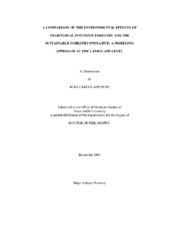| dc.description.abstract | Changes in landscape pattern caused by changes in forest management, namely the Sustainable Forestry Initiative (SFI), and the implications of these structural changes on landscape processes were analyzed. Landscape structure was studied based upon the comparison of landscapes with different management histories. Ecological processes were analyzed based upon simulation of stand and landscape attributes of habitats for several vertebrate species and upon simulation of hydrological processes such as water and sediment yield. A methodology to integrate landscape and stand pattern and dynamics with landscape processes was developed for this work. It integrates a forest landscape structure model, several stand level growth and yield models, vertebrate habitat models, and a hydrological model. The comparisons among landscapes revealed that forest management has a strong influence on landscape structure. The SFI program increases fragmentation of the landscape indicated by the presence of more and smaller patches, more edges, more complex shapes, and less and smaller core areas. Traditional intensive and extensive management show comparable patterns characterized by high aggregation and connectivity. Landscapes managed according to the SFI program show higher Habitat Suitability Index (HSI) values for American woodcock, American beaver, wild turkey, fox squirrel, and gray squirrel. HSI is higher for pine warbler in the landscape not managed according to the SFI program. Downy woodpecker and barred owl present very reduced HSI values in either landscape. The SFI program induced fragmentation of the habitat of pine warbler and the establishment of narrow and elongated habitats in a network structure for the remaining species. Both patterns are determined by SMZs. The scenario representing management according to the SFI program presents higher sediment yield at the watershed level than the scenario representing management not according to the SFI program due to higher channel erosion related to the absence of buffer strips in the non-SFI scenario. In general, management according to the SFI program increases landscape diversity and evenness, habitat suitability for most species, potential vertebrate diversity, and provides habitat structure suitable for most species. This management also decreases sediment loss at the watershed level. | en |


